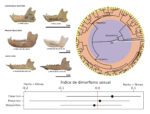Variação do dimorfismo sexual do tamanho da mandíbula em primatas (Catarrhini, Platyrrhini e Strepsirrhini)
Natália Borges de Melo, Nilton Carlos Cáceres, Jamile de Moura BubaduéOs primatas têm uma história de vida complexa, ampla distribuição geográfica e variabilidade ecológica e reprodutiva, características que podem contribuir para a variação fenotípica. Eles podem ser divididos em três grandes grupos monofiléticos: Strepsirrhini de Madagascar, África continental e Ásia; Catarrhini da África, Europa e Ásia; e Platyrrhini da América do Norte, Central e do Sul. O presente estudo pretende descrever a variação do dimorfismo de tamanho da mandíbula nos clados de primatas, com dados padronizados utilizando a morfometria geométrica. Calculamos o índice de dimorfismo sexual para 102 espécies de primatas (19 Strepsirrhini, 54 Catarrhini e 29 Platyrrhini). Constatamos que machos tendem a ser frequentemente maiores que as fêmeas, embora o contrário também aconteça com alguma frequência. A disparidade, quantidade de variação, do índice do dimorfismo é maior em Platyrrhini, seguido de Catarrhini e por último Strepsirrhini. A maior disparidade em Platyrrhini se deve principalmente à alta variação do dimorfismo em Callitrichidae, que apresenta altos valores de dimorfismo tanto com viés para fêmeas quanto para machos, e aos altos valores de dimorfismo com viés para machos em Atelidae e Cebidae. Catarrhini apresenta dimorfismo mais frequentemente relacionado ao aumento do tamanho de machos, enquanto em Strepsirrhini os animais tendem a ser monomórficos. Nossos resultados indicam a possibilidade de que a evolução do dimorfismo do tamanho seja resultado de processos adaptativos e biogeográficos ao longo da diversificação do grupo. Encorajamos estudos futuros a analisarem diferentes hipóteses adaptativas na evolução do dimorfismo de tamanho em Primatas.
Sexual size dimorphism in clades of primates. Primates have complex life histories, wide geographic distributions, and ecological and reproductive variability, characteristics that may contribute to phenotypic variation. They can be divided into three major monophyletic groups: Strepsirrhini from Madagascar, continental Africa, and Asia; Catarrhini in Africa and Asia; and Platyrrhini in the Americas. Here, we aimed to describe the size dimorphism of the mandible in the main primate clades using standardized geometric morphometric data. We calculated the index of sexual dimorphism for 102 primate species (19 Strepsirrhini, 54 Catarrhini, and 29 Platyrrhini). Our results show that males are often larger than females, although the opposite also occurs with some frequency. The disparity of sexual dimorphism, the amount of variation, is higher in Platyrrhini, followed by Catarrhini, and then Strepsirrhini primates. The higher disparity in Platyrrhini is particularly due to the high disparity in Callitrichidae, which have high values for both female- and male-bias dimorphism, along with the high levels of male-biased sexual dimorphism in Atelidae and Cebidae. Catarrhini sexual dimorphism is frequently male-biased, while Strepsirrhini species tend to be more monomorphic. Our results suggest that the evolution of sexual dimorphism may be a consequence of adaptive and biogeographic processes throughout the diversification of the groups. We encourage future studies to analyze different adaptive hypotheses for the evolution of sexual size dimorphism in primates.
